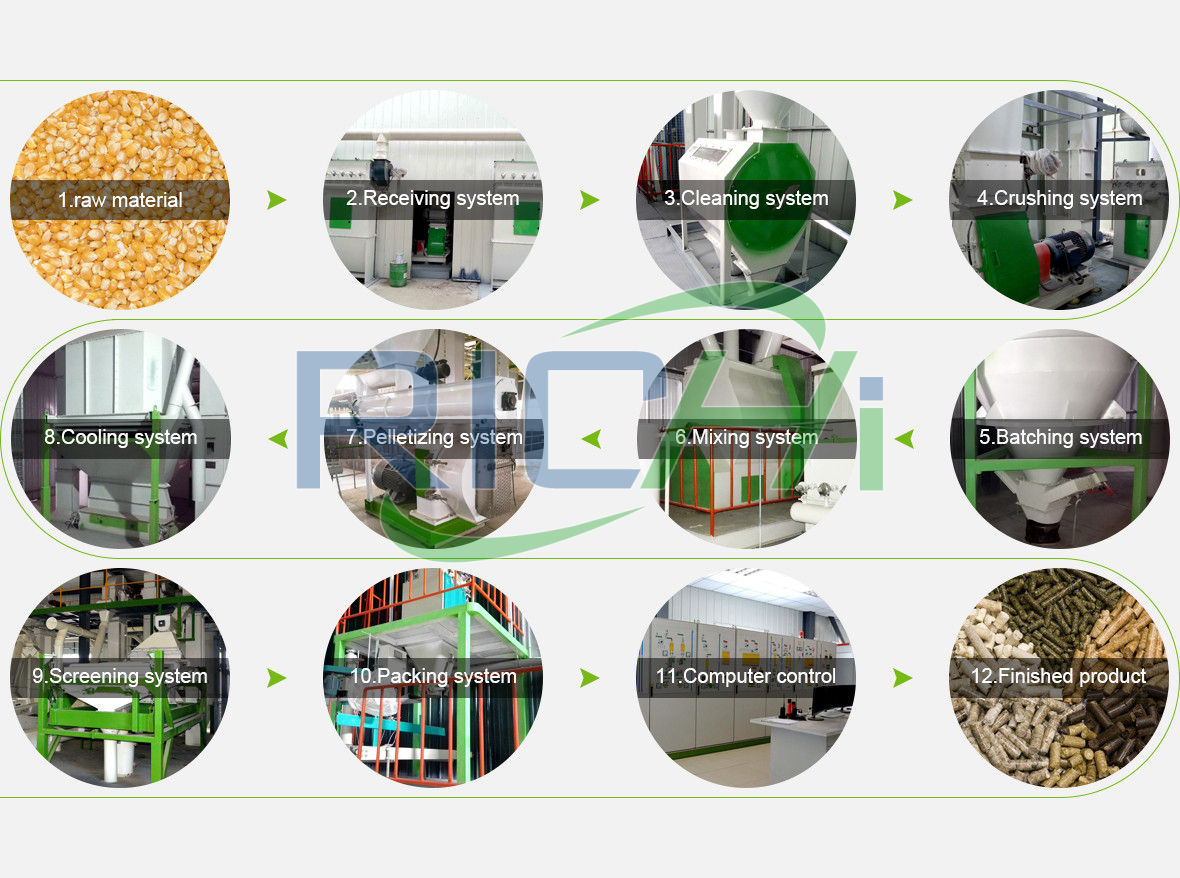Which step is the most important in making pellet feed in poultry feed mills? Of course, it is the steam preparation of the poultry feed pellet making machine. As we all know, the main machine of poultry feed mnufacturing machine in is mainly composed of feed, stirring, pelletizing, transmission and lubrication systems.
The working process of the poultry feed pellet making machine is that the mixed powder with a moisture content of not more than 15% enters the feeding auger from the hopper, and the appropriate material flow is obtained by adjusting the speed of the stepless speed regulating motor, and then enters the feed mixer, and is mixed with steam by the stirring rod. quality.
If you need to add molasses or grease, you can also add it from the mixing drum with steam.

Question 1: The importance of steam deployment in complete set poultry feed making machine
There are many factors that affect the quality of pellets, which are made by poultry feed pellet making machine. It is generally believed that feed formulation has the greatest impact on pellet quality, and steam conditioning can play a greater role on the basis of formulation.
In industrial production, most poultry feed mills use the wrong steam method. Try to use high-pressure high-temperature steam to increase the adjustment temperature and increase the water absorption capacity. But this idea was wrong from the start!
Over-temperature steam mainly provides sensible heat, but cannot meet latent heat and humidity requirements. The elevated temperature steam is fed into the regulator with superheated steam.
Superheated steam has high sensible heat, can quickly reach the temperature signal sensor, and reach the set temperature of 85 ℃ – the sensor sends a signal to adjust the automatic flow control valve into the steam flow. Therefore, the steam flow into the conditioner is not large. Water vapor is reduced, latent heat is reduced, and water content is reduced. (Related case: pellet production line in Thailand)
It should be noted that steam granulation is mainly water, and heat is closely related to temperature. You cannot only focus on one and ignore the other. In fact, people often ignore the important factor of moisture, and blindly emphasize the tempering temperature.
Question 2: Too short a conditioning stay is a common problem.
Many people don’t notice the conditioning time of soda water, some conditioning time is only 3-5 seconds, which has a very adverse effect on achieving the ideal steam-material relationship. It should be emphasized that, before the cooked raw starch is transferred from the poultry feed pellet making machine conditioner to the conditioner, it must be highly valued that the cooked raw starch reaches the set temperature.
The total retention time of the preconditioner and the time inside the conditioner boils down to “total conditioning time”, which is inconceivable because it ignores all the logic of food science.
Question 3: The problem caused by insufficient conditioning is the reason for the decrease in moisture absorption after steam conditioning.
In the production process of pellet feed, steam conditioning is not ideal. Adding feed to poultry pellet feed improves the economic benefits of broiler production by improving feed efficiency of poultry feed pellet making machine. (Related case: feed mill plant in Uzbekistan)
This is mainly attributable to reducing feed waste, increasing volume, increasing nutrient concentration, indiscriminate feeding, reducing time and energy for feeding, reducing component segregation, destruction of feed pathogens, thermal denaturation of starch and protein, and improving palatability.
However, if proper temperature conditioning is not employed, particulates can cause poor production performance.
The results show that granulation can cause changes in starch properties, and it is not easy to be hydrolyzed by enzymes. Previously adding broilers to a conditioned basal diet at 93°C resulted in significantly reduced weight gain and increased feed consumption compared to 85°C.
Due to the loss of lysine and arginine due to maillard reaction, starch ages into anti-enzymatic starch, resulting in energy loss. Drain, these are known negative effects of high temperature conditioning.
Starch can also lead to reduced starch digestibility if not heated properly. Amylose can recrystallize after heating, and its digestibility is lower than before heating. Overheated starch can cause caramelization reactions, mainly the condensation of amino acids and sugars into indigestible maillard products.
Increasing the poultry feed pellet making machine conditioning temperature could increase the yield of the wheat basal diet, but had no significant effect on the corn basal diet. This finding may be due to differences in the gelatinization properties of wheat starch at lower gelatinization temperatures compared to corn.
Compared with corn starch, wheat flour can provide a higher gelatinization temperature than corn starch after conditioning at 90 °C, thereby increasing the PDI of wheat-based daily feed. However, it should be noted that during the poultry feed pellet making machine conditioning process, due to the low water content, the degree of gelatinization during granulation is generally low.
Except for the gelatinized starch, the components are mainly used to improve the physical quality of the granules. The results showed that with the increase of poultry feed pellet making machine conditioning temperature, the PDI of the wheat basal diet was improved, but there was indeed a negative effect on weight gain and feed absorption and utilization.
Therefore, although it is generally believed that the durability of poultry feed pellet making machine pellets is related to better production performance, the high durability of pellets obviously cannot overcome the adverse effects of high temperature conditioning on production performance.
Because of the mechanical shear force, high temperature, conditioning time, moisture and other factors in the feed processing process, it can cause the denaturation of feed protein, but the solubility is reduced and the digestibility utilization rate is increased.
In general, heating increases protein digestibility by inactivating enzyme inhibitors, and heating denatures proteins, allowing more enzyme access to sites. Improper vapor conditioning can greatly affect digestible protein content.










